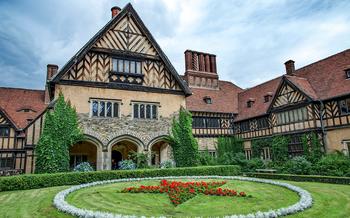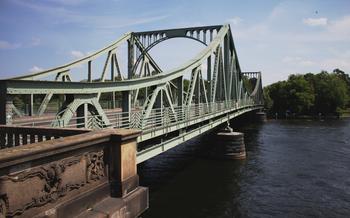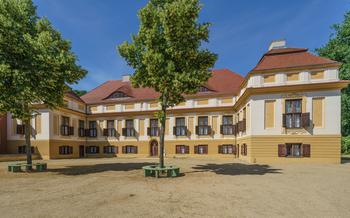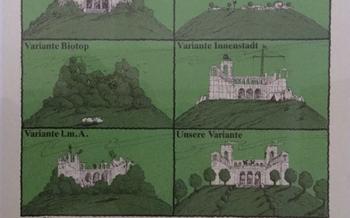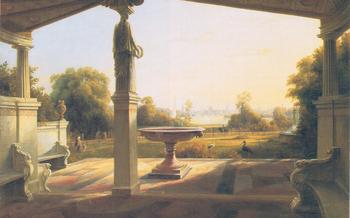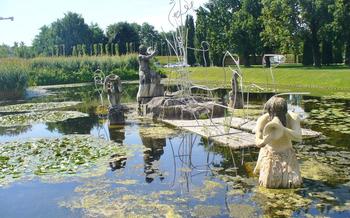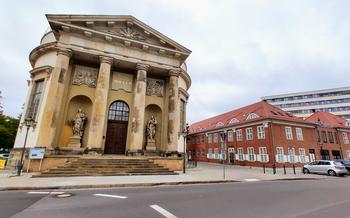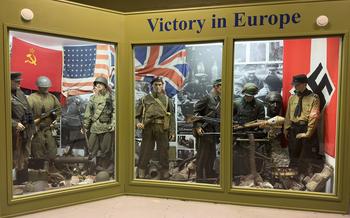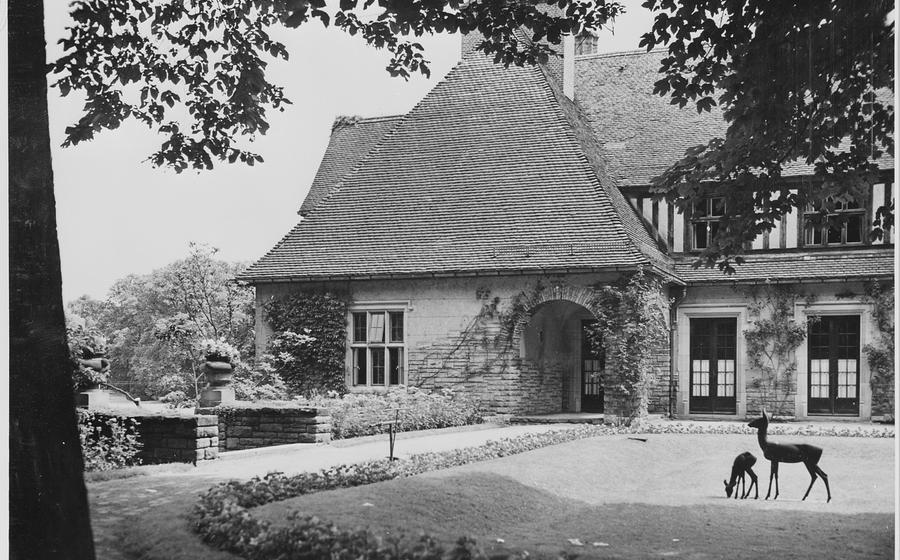
The Cecilienhof Palace in Potsdam
- The Cecilienhof Palace in Potsdam: A Historical Gem
- Location and Transportation
- Guided Tours and Admission Fees
- Highlights of the Palace Interior
- Beautiful Gardens and Surrounding Area
- The Potsdam Conference and Its Legacy
- Symbolic Meaning of the Palace
- Practical Tips for Planning Your Visit
- Exploring Potsdam's Other Historical Sites
- Cultural Events and Exhibitions
- Accessibility for Visitors with Disabilities
- History of the Hohenzollern Family
- Architectural Details and Design Elements
- Conservation and Restoration Efforts
- Insider Tip: Exploring the Park Sanssouci
The Cecilienhof Palace in Potsdam: A Historical Gem
The Cecilienhof Palace stands as a testament to the rich history and architectural heritage of Germany. Built between 1914 and 1917 as a summer residence for Crown Prince Wilhelm and his wife Cecilie, the palace is a stunning example of English Tudor Revival architecture. Its unique design, featuring half-timbered gables, intricate brickwork, and a striking tower, sets it apart from other palaces in the region. The palace gained international prominence as the venue for the Potsdam Conference in 1945, where the leaders of the Allied powers, Winston Churchill, Harry Truman, and Joseph Stalin, met to decide the fate of post-World War II Europe. Today, the Cecilienhof Palace serves as a museum open to the public, offering visitors a glimpse into its fascinating history and the events that shaped the course of modern European history.
Location and Transportation
The Cecilienhof Palace is situated in the picturesque city of Potsdam, just a short distance from Berlin. Its exact address is Im Neuen Garten, 14469 Potsdam. Potsdam is easily accessible from Berlin via public transportation. Visitors can take the S-Bahn (S7) or regional trains (RE1, RB21, RB22) from Berlin Hauptbahnhof or Berlin Zoologischer Garten to Potsdam Hauptbahnhof. From there, you can take bus line 695 or 605 to the "Cecilienhof" stop, which is located right in front of the palace.
For those driving from Berlin, take the A115 highway and follow the signs to Potsdam. The palace is well-signposted and easy to find. Ample parking is available on-site, making it convenient for visitors arriving by car.
The Cecilienhof Palace is wheelchair accessible, with designated parking areas and accessible entrances. Visitors with disabilities can also rent wheelchairs on-site. The palace also provides audio guides in various languages, making it accessible to visitors from all over the world.
Guided Tours and Admission Fees
Guided tours of the Cecilienhof Palace are available in various languages, including English, German, French, and Russian. These tours provide an in-depth exploration of the palace's history, architecture, and significance. The cost of admission tickets varies depending on the type of ticket and the number of visitors. Adult tickets typically range from 10 to 12 euros, while children and students often receive discounted rates. Group discounts are also available for larger parties. Advance booking is recommended, especially during peak tourist season, to avoid long lines and secure your preferred tour time. Online booking options are available on the palace's official website, where you can also find information on current exhibitions and events.
Highlights of the Palace Interior
Stepping inside the Cecilienhof Palace is like stepping back in time. The palace's interior is a treasure trove of historical artifacts, opulent furnishings, and intricate architectural details. Notable rooms to look out for include the Great Hall, with its soaring ceilings and grand staircase, and the Music Room, adorned with exquisite tapestries and a magnificent pipe organ. The State Dining Room is where the famous Potsdam Conference took place, and visitors can still see the original table and chairs used by the world leaders.
Throughout the palace, visitors will find exhibits and displays that tell the story of the palace's past occupants and the events that unfolded within its walls. Personal belongings, photographs, and documents offer a glimpse into the lives of the Hohenzollern family, while interactive exhibits shed light on the Potsdam Conference and its impact on world history.
One of the most fascinating aspects of the palace's interior is the collection of stories and anecdotes related to its former inhabitants. Visitors can learn about the lavish parties and social gatherings that were held in the palace, as well as the private lives and struggles of the Hohenzollern family. Guides and audio tours provide insights into these stories, bringing the palace's history to life.
Beautiful Gardens and Surrounding Area
The Cecilienhof Palace is surrounded by beautifully landscaped gardens, offering visitors a tranquil oasis to relax and explore. The gardens were designed in the English landscape style, characterized by rolling hills, winding paths, and picturesque ponds. Visitors can stroll through the serene gardens, admiring the colorful flowerbeds, manicured lawns, and majestic trees.
One of the highlights of the gardens is the Friendship Rose Garden, which features over 2,000 roses of various colors and fragrances. Visitors can enjoy the beauty and aroma of these vibrant roses while taking a leisurely walk through the garden.
The surrounding area of the Cecilienhof Palace is also rich in historical landmarks and attractions. Just a short walk away is the Glienicke Bridge, which spans the Havel River and connects Potsdam with the neighboring town of Wannsee. The bridge is known for its beautiful architecture and stunning views of the surrounding landscape.
Visitors can also explore the nearby Babelsberg Park, which is home to the Babelsberg Palace and the Babelsberg Film Studio. The palace is a beautiful example of 19th-century architecture, while the film studio is one of the oldest and largest in Europe.
With its beautiful gardens and surrounding attractions, the Cecilienhof Palace offers visitors a unique opportunity to immerse themselves in history, nature, and culture. Whether you are interested in exploring the palace's interior, strolling through the serene gardens, or visiting the nearby historical sites, there is something for everyone to enjoy at the Cecilienhof Palace.
The Potsdam Conference and Its Legacy
The Cecilienhof Palace holds a significant place in world history as the venue for the Potsdam Conference, a pivotal event that shaped the political landscape of post-World War II Europe. Held from July 17 to August 2, 1945, the conference brought together the leaders of the victorious Allied powers: Harry S. Truman (United States), Winston Churchill (United Kingdom), and Joseph Stalin (Soviet Union).
The conference had far-reaching implications, with decisions made on the division of Germany into occupation zones, the establishment of the Oder-Neisse line as the new border between Poland and Germany, and the creation of the Council of Foreign Ministers to oversee the peace process. These decisions laid the foundation for the Cold War era, dividing Europe into Eastern and Western blocs and setting the stage for decades of political and ideological rivalry.
The Potsdam Conference was a turning point in international relations, marking the end of the wartime alliance and the beginning of a new era of superpower rivalry. The decisions made at the conference had a profound impact on the lives of millions of people and continue to shape the geopolitical landscape of Europe today.
Symbolic Meaning of the Palace
The Cecilienhof Palace stands as a powerful symbol, embodying Germany's rich history and its journey toward reconciliation. It represents the nation's resilience in the face of adversity and its commitment to international cooperation and diplomacy. The palace serves as a reminder of the devastating consequences of war and the importance of finding peaceful solutions to conflicts.
As a venue for the Potsdam Conference, the palace witnessed the shaping of post-World War II Europe. The decisions made within its walls had a profound impact on the political landscape of the continent, influencing the division of Germany, the establishment of new borders, and the rise of the Cold War.
In the years that followed, the palace became a symbol of reconciliation between East and West Germany. After the fall of the Berlin Wall, it underwent extensive renovations to restore its former glory. Today, it stands as a testament to the power of unity and cooperation, embodying the spirit of a nation that has overcome its divisions and emerged stronger.
The Cecilienhof Palace is recognized as a cultural heritage site of immense significance, attracting visitors from around the world. Its symbolic meaning resonates with people of all backgrounds, serving as a reminder of the importance of peace, understanding, and the interconnectedness of nations.
Practical Tips for Planning Your Visit
To make the most of your visit to the Cecilienhof Palace, consider the following practical tips:
-
Timing your visit: The palace is open year-round, but the best time to visit is during the spring or summer months when the weather is pleasant, and the gardens are in full bloom.
-
Duration of the visit: Plan to spend at least two to three hours exploring the palace and its grounds. This will give you enough time to visit the interior, stroll through the gardens, and learn about the palace's history.
-
Food and beverage: There is a café on-site that offers a variety of refreshments, including snacks, sandwiches, and drinks. However, if you prefer to bring your own food, there are designated picnic areas in the surrounding park where you can enjoy a meal outdoors.
Exploring Potsdam's Other Historical Sites
Potsdam is a treasure trove of historical landmarks beyond the Cecilienhof Palace. If you have time, be sure to explore other significant sites that offer a glimpse into the city's rich past.
-
Sanssouci Palace: The summer palace of Frederick the Great, this UNESCO World Heritage Site is renowned for its elegant Rococo architecture and stunning gardens. Don't miss the chance to stroll through its picturesque park and admire the intricate sculptures and fountains.
-
Glienicke Bridge: This graceful bridge, spanning the Havel River, connects Potsdam to the neighboring town of Wannsee. Admire its Neo-Gothic towers and learn about its symbolic role during the Cold War, when it served as a crossing point between East and West Berlin.
-
Babelsberg Palace: Located on the shores of the Glienicke Lake, Babelsberg Palace is another architectural gem from the 19th century. Explore its English-style park, admire its neo-Gothic facade, and delve into the stories of the royal family who once resided here.
-
Pfingstberg Tower: For panoramic views of Potsdam and the surrounding countryside, climb to the top of the Pfingstberg Tower. This 46-meter-high observation tower offers breathtaking vistas and is a popular spot for photography enthusiasts.
-
Alexandrowka: Discover the unique Russian colony of Alexandrowka, established by Frederick William III in the early 19th century. Explore its charming wooden houses, learn about the history of the Russian settlers, and visit the Russian Orthodox Church of St. Alexander Nevsky.
Cultural Events and Exhibitions
The Cecilienhof Palace is not only a historical site but also a vibrant cultural hub that hosts temporary exhibitions and cultural events throughout the year. These events provide visitors with an opportunity to delve deeper into the history of the palace, its occupants, and the surrounding area.
Temporary exhibitions at the palace often showcase artifacts, documents, and multimedia displays that shed light on various aspects of the palace's history, the Potsdam Conference, and the Hohenzollern family. These exhibitions are curated by experts and offer a unique perspective on the palace's significance.
Cultural events, such as concerts, lectures, and workshops, are also held regularly at the palace. These events bring together historians, artists, and performers to explore the cultural heritage of the palace and its surroundings. Visitors can attend concerts featuring classical music, jazz, or contemporary compositions inspired by the palace's atmosphere. Lectures and workshops offer insights into the history of the palace, the Potsdam Conference, and the Hohenzollern family.
To make the most of your visit, it is advisable to check the palace's website or contact the visitor center in advance to find out about upcoming events and exhibitions. Special programs and activities for families and children are also organized periodically, making the palace an ideal destination for visitors of all ages.
By attending cultural events and exhibitions at the Cecilienhof Palace, visitors can gain a deeper understanding of the palace's history, its role in shaping modern Europe, and its enduring cultural significance.
Accessibility for Visitors with Disabilities
The Cecilienhof Palace is committed to ensuring that all visitors, regardless of their abilities, can enjoy a fulfilling and accessible experience. The palace features designated parking areas for visitors with disabilities, located close to the main entrance. Accessible entrances and ramps allow for smooth movement throughout the palace's grounds.
Inside the palace, visitors with disabilities can take advantage of audio guides that provide detailed descriptions of the exhibits and historical context. These audio guides are available in various languages and can be easily requested at the ticket counter. For those with visual impairments, tactile models and descriptive panels are provided to enhance their understanding of the palace's layout and features.
The Cecilienhof Palace also offers accessible restrooms and elevators to facilitate easy movement between floors. Visitors with mobility challenges can rent wheelchairs or electric scooters, subject to availability, to aid in their exploration of the palace.
The staff at the Cecilienhof Palace is trained to assist visitors with disabilities, providing information and directions as needed. With its commitment to inclusivity, the palace ensures that everyone can participate in the rich historical and cultural experience it offers.
History of the Hohenzollern Family
The Cecilienhof Palace was commissioned by Crown Prince Wilhelm, the eldest son of German Emperor Wilhelm II, and his wife, Duchess Cecilie of Mecklenburg-Schwerin. The Hohenzollern family, to which Wilhelm belonged, had a long and storied history in Germany, tracing their lineage back to the 11th century. They ruled Prussia for over two centuries and played a significant role in German unification in the 19th century.
Wilhelm's father, Emperor Wilhelm II, was the last German emperor. During his reign, Germany went through a period of rapid industrialization and expansion, but also faced growing social and political tensions. Wilhelm and Cecilie were known for their liberal and progressive views, and they sought to modernize the monarchy and address some of the pressing issues of the time.
The construction of the Cecilienhof Palace was a testament to the Hohenzollerns' desire to embrace modernity while preserving their historical legacy. The palace was designed in the English Tudor style, a departure from the traditional Baroque and Rococo styles favored by the Hohenzollerns in the past. It incorporated modern amenities such as central heating, electric lighting, and indoor plumbing, while still retaining the grandeur and opulence befitting a royal residence.
The Hohenzollerns' connection to the Cecilienhof Palace ended with the abdication of Wilhelm II in 1918 and the fall of the German monarchy. However, the palace remains a symbol of their legacy and their role in shaping German history. It stands as a reminder of the Hohenzollerns' ambition, their desire for progress, and their enduring influence on the nation.
Architectural Details and Design Elements
The Cecilienhof Palace showcases a remarkable blend of architectural styles, reflecting the evolving tastes and influences of its time. The palace's exterior is characterized by its neo-Baroque design, with its symmetrical façade, intricate carvings, and elegant balconies. The interior, on the other hand, features a mix of Rococo and Art Deco elements, creating a unique and eclectic aesthetic.
One of the most striking features of the palace is its impressive tower, which offers panoramic views of the surrounding park and the Havel River. The tower's design is inspired by medieval fortifications, adding a touch of grandeur to the overall appearance of the palace.
The Cecilienhof Palace also boasts a beautifully designed roofline, with its distinctive gables and dormers. The intricate detailing of the roof, along with the use of different roofing materials, adds depth and texture to the palace's exterior.
Overall, the Cecilienhof Palace is a testament to the architectural prowess of its designers. Its harmonious blend of styles and its attention to detail make it a captivating sight to behold and a true architectural gem in Potsdam.
Conservation and Restoration Efforts
The Cecilienhof Palace has undergone extensive conservation and restoration efforts throughout its history to preserve its historical integrity and architectural significance. These efforts have involved meticulous attention to detail and collaboration between experts in various fields, including architects, historians, and conservators.
One of the major challenges faced during restoration was the need to repair damage caused by war and neglect. The palace suffered significant damage during World War II, and subsequent years of disuse led to further deterioration. Restoration work involved carefully repairing the damaged portions of the building while maintaining its original character.
Another challenge was the need to balance conservation with modernization. While it was important to preserve the palace's historical features, it was also necessary to adapt it to meet contemporary needs and standards. This involved installing modern amenities such as heating, electricity, and plumbing without compromising the palace's architectural integrity.
The successful restoration of the Cecilienhof Palace is a testament to the dedication and expertise of the individuals involved. Their efforts have ensured that this iconic landmark can continue to be enjoyed and appreciated by visitors from around the world.
Insider Tip: Exploring the Park Sanssouci
For a truly immersive experience, don't miss the opportunity to explore the enchanting Park Sanssouci, located just a short walk from the Cecilienhof Palace. This sprawling park, with its meticulously landscaped gardens, serene ponds, and elegant architectural follies, is a UNESCO World Heritage Site and one of Potsdam's most beloved attractions.
Take a leisurely stroll through the park's winding paths, admiring the colorful flower beds, towering trees, and intricate sculptures. Be sure to visit the Sanssouci Palace, the former summer palace of Frederick the Great, which is renowned for its exquisite Rococo architecture and lavish interiors.
Don't miss the Picture Gallery, which houses a collection of over 1,000 paintings by European masters, including works by Caravaggio, Rubens, and Rembrandt. For a unique perspective, climb to the top of the Belvedere on Klausberg hill, which offers breathtaking panoramic views of the park and the city of Potsdam.
Whether you're a history buff, a nature lover, or simply looking for a tranquil escape, Park Sanssouci promises an unforgettable experience. Pack a picnic lunch and find a secluded spot to relax and soak in the beauty of this idyllic setting.

